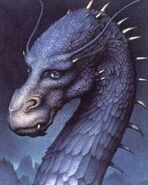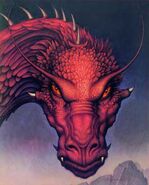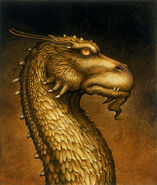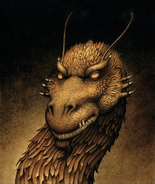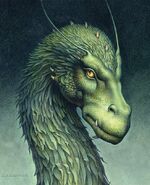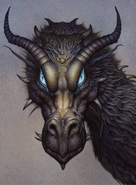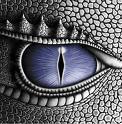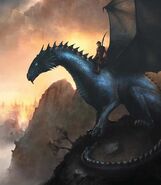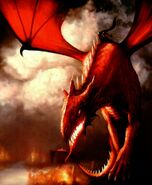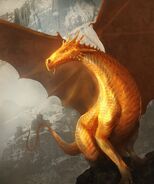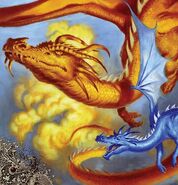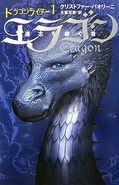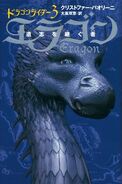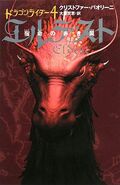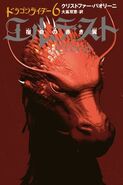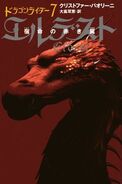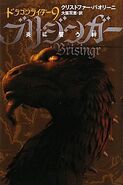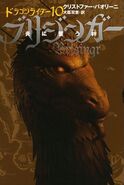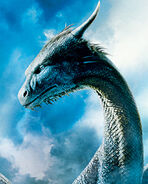Dragons were an ancient race of sentient reptilian creatures native to the land of Alagaësia. While most roamed free and did not commonly associate with the civilizations of other races, a significant number were the mounts and lifelong companions of the Dragon Riders. Along with werecats, spirits, Lethrblaka and Nïdhwal, dragons were among the few known sentient non-humanoid species.
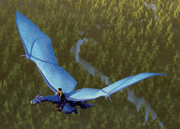
There were only five known dragons left in Alagaësia following the Dragon War: Shruikan, Glaedr, Thorn, Saphira II and Fírnen (though Thorn, Saphira and Firnen were still eggs). However, unbeknownst to everyone, a significant number of eggs and Eldunarí remained hidden on Vroengard, the ancient home of the Riders, after the Forsworn plundered the island. During the events of the Rider War, Glaedr was murdered by Galbatorix (through Murtagh and Thorn) and henceforth resided in his Eldunarí, which was in Eragon's possession. Following the Rider War Eragon, Saphira II, Glaedr and the other Eldunarí left Alagaësia for lands to the east to raise the next generation of dragons in safety and to rebuild the Dragon Riders.
Description[]
The dragons of Alagaësia were carnivorous flying reptiles, with scales, sharp teeth, four legs, bat-like membraned wings and a tongue that was covered with hooked barbs. They developed the ability to breathe fire as they matured. Their color varied from dragon to dragon, and some dragons could even be multi-colored[1] or have clear scales[2]. According to Brom, dragons could grow to be "larger than a house"[3] and some older dragons could be confused with large hills.[3] They were connected to the land in strange ways, ways that sometimes even they could not control. This was shown when Saphira touched Zar'roc with her muzzle, causing it to ripple,[4] when she turned Brom's grave from sandstone to diamond, and when she repaired the Isidar Mithrim. Dragons have an immense pool of energy to use magic, but can't summon it at their own will or with the Ancient Language.
Dragon eggs tended to be the same color as the dragon's scales, as did the color of their Rider's magic (in this case, the Rider's magic would usually change to match the color of their dragon if it didn't already).[5] Their scales were very strong, capable of deflecting arrows, even on the underbelly. The wings were the weakest part of their body, composed of only a thin membrane of flesh (Saphira often had holes punched in them once her wards failed). Females tended to be more aggressive, and vain than males: Saphira often called herself the "most beautiful creature in all of Alagaësia", as well as attacking Glaedr when he decided not to mate with her. Glaedr himself said that in the wild, the "females were so formidable, it was considered among the bonded dragons a great achievement to mate with one". For most dragons, the color of their eyes and hide matched (with the exception of Fírnen and Shruikan). The dragons also contained barbed tongues which were used to strip meat. All dragons ate meat, especially deer and other ungulates. The dragons were similar to other creatures, namely the Nïdhwal and the Fanghur who were said by Glaedr to be "cousins of the dragons", however, whilst the Nïdhwal were of comparable intellect to the dragons, the Fanghur were far inferior. The Lethrblaka were also said to resemble the dragons somewhat in their appearance.
In Brisingr, it is implied that dragons interact with each other using their tails: Glaedr states, "Even after so long bonded to Oromis, he still had difficulty discerning the emotions of the two legs, what with their soft, flat faces and their lack of tails." From this, it can be inferred that dragons express at least some of their feelings with their tails.
Unusual Cases[]
It is possible for a Dragon to have two heads, but such dragons might be too contentious to bond with a rider'[6].
Life cycle[]

Saphira after hatching from her egg.
Dragons hatched from eggs. Dragons hatched from larger eggs were usually larger[7]. Dragon twins are possible[8]. When dragons reached about six months old, they gained the ability to breathe fire. Predators by nature, they hunted large animals, with an occasional fish or fowl and some plants, such as Fireweed, which eased bad breath and indigestion. Dragons are particularly fond of the giant snail, Snalglí.
Dragons started to mate when they were young; they could mate at the same age they learned to breathe fire (around 6 months old. They were unfading and did not die, unless by wounds in battle or by sickness. There was no limit to a dragon's size, as they grew continuously. Brom said that the most ancient dragons could be confused for hills or small mountains because of this: a dragon's size directly correlated to the size of the Eldunarí. The largest known dragon was Belgabad. Once dragons grew very old, they spent most of their time asleep, dreaming.
When the Unbound Dragons delivered one of their eggs to the Riders, certain words were said over it. These ensured that the dragon would only hatch for the one destined to be its Rider.
When a dragon hatches for their rider, a subcouncious bond is formed and their minds become more three / one instead of two. They can feel each other's pain and if one of them die, the other, in most cases, will become mad and try to "avenge" the other's death and then eventually die of grief. There are cases where this may not happen exactly to the letter, but they are not many. However in the case the dragon died, they could (and can) chose to retain their conscious mind in their Eldunarí, or their jewel-like "heart of hearts". This allowed anyone with the Eldunarí - if it was given to someone - to speak to the dragon and draw energy from them. A dragon and Rider who experienced the bodily death of the dragon would become known as Indlvarn, and would have to adjust to the difficult transition of the dragon being confined to its Eldunari. Many Indlvarn served with prominent distinction during the Riders' golden age. It was revealed by the elf Oromis that Galbatorix, during his rebellion, acquired all the Eldunarí he could from the dragons he murdered, which was the source of his amplified power. He also gave some of them to Murtagh, which explains his increased power.
But though Galbatorix did collect all the available eggs and Eldunarí, there were many hidden in the Vault of Souls underneath the Rock of Kuthian on Vroengard. Galbatorix was oblivious of this due to Thuviel immolating himself on Vroengard during the Slaughter at Doru Araeba. Also, the amount of Eldunarí stored within the Vault of Souls was small enough (compared to the amount in the vault the riders created for Eldunarí on Vroengard) that their absence would not arouse Galbatorix's suspicion. When Eragon, Saphira and Glaedr (eldunarí) visited the chamber, they discovered that the deceased dragons had contributed much to all of their lives, such as healing Eragon's back during the Blood-oath Celebration.
In the movie, the link between the dragons and their riders has a different twist: the dragon can die, but if the rider dies first, both die at the same time.
History[]
Early years[]
Along with the dwarves and the Grey Folk, dragons were one of the three races native to Alagäesia. The dwarves and the dragons constantly had skirmishes and neither ever found any liking for the other race. Additionally, there were never any dwarf Dragon Riders because the dwarves were not included in the Blood Oath (The magical pact that created the Riders).
Du Fyrn Skulblaka[]
After a dragon was killed by a rash elf, the long and bitter Fyrn Skulblaka started between the two races. Each side did things they would regret: at one point, elves ambushed dragon mothers in a forested nesting-place (Stone of Broken Eggs), killing them and breaking their eggs. Eventually, however, an elf named Eragon I (namesake of the current Eragon) discovered an abandoned dragon egg and raised the dragon as his own. Together, the pair acted as mediators for the dragons and elves, as well as were able to eventually resolve the conflict. Afterward, they established a pact or Blood Oath and created the order of the Dragon Riders, binding the Dragons and the Elves together with magic, as it was determined that a simple peace accord would not suffice. The dragons and their Riders were tasked with maintaining the peace in Alagäesia. Humans were later added to the blood oath when they arrived.
The Dragon Rider Era[]
The dragons agreed to give some of their eggs to the Riders every year so that the order could continue. With the protection and assistance of the Riders, the dragons experienced an age of peace. Though they still had contentions with the dwarves, a full-scale war never again erupted between races.
The Fall[]
During and after Galbatorix's rebellion, most of the dragons, along with their Riders, were murdered. The Forsworn began a mass genocide of the dragons, leaving them on the brink of extinction. Galbatorix's dragon was thought to be the only surviving dragon. However, Galbatorix still held three dragon eggs and there was another surviving dragon, Glaedr, living in Du Weldenvarden. By Eragon's time, there were only five known dragons in existence:
- Saphira: Eragon's dragon, a blue female and the only surviving dragoness. The only known surviving daughter of Iormúngr and Vervada
- Thorn: Murtagh's dragon, a red male
- Fírnen: Arya's dragon, a green male
- Shruikan: Galbatorix's dragon, a black male (died in the battle of Urû'baen by the hand of Arya)
- Glaedr: Oromis's dragon, a gold male (experienced bodily death during the elven invasion of Gil'ead in Brisingr and from then on resided in his Eldunarí)
New Hope[]
When Eragon discovered the blue dragon egg in the Spine and eventually became Saphira's Rider, some hope was restored for the dragons. Galbatorix also wanted to reestablish the dragon race and the Riders to serve him.
Saphira was the last known female dragon in existence. As revealed by Murtagh, it was Galbatorix's desire to reestablish the order of the Dragon Riders. Therefore, it was likely that Saphira would have become the "mother" of their race.
But in the Vault of Souls, Eragon found that Vrael, Oromis, and a few other elders had realized that Galbatorix was too powerful and decided to hide away 136 Eldunarí and 243 dragon eggs[9], 26 of which were saved for the new generation of Dragon Riders and then the Eldunarí cast a spell like that of the Banishing of Names, that erased the memory of the Rock of Kuthian from everyone's minds, including that of the Riders and the mothers of the dragon eggs. This spell would also prevent anyone who entered and left the vault from remembering the dragon eggs in the vault until the demise of Galbatorix. Eragon took these eggs with him at the end of Inheritance.
But the dragons continued to play a role in the working of Alagäesia, in the form of the tamperings worked by the Eldunarí within the Vault of Souls. They did many things to help bring about Galbatorix's downfall, such as reaching out to the Werecats and giving them the message they would later pass on to Eragon, which would lead him to find both the Brightsteel for his sword, Brisingr, but also to find the Vault of Souls.
Naming[]
In response to a fan question, Christopher Paolini stated that dragons would normally choose their own names once they were old enough to understand the concept.[10] Additionally, it wasn't unheard of for a dragon to change his or her name over the centuries. In a perversion of the normal custom, Galbatorix gave Shruikan his name.
In the first book, when Eragon asked Brom about dragons and the Dragon Riders, he asked him about the names of the former dragons before the fall of the order. Amongst them was Saphira, the name of Brom's former dragon. Later, Eragon shares the list of names with her and she chooses Saphira. Also, when Murtagh explains why his dragon is named Thorn, it is unclear whether Thorn chose his name or Murtagh. Christopher Paolini has stated in an interview that Thorn did indeed choose his own name.[11]
Dragons mentioned within the series[]
- Agaravel, tamed, a female dragon in her Eldunarí whose rider was murdered by Kialandi and Formora. Kept under Galbatorix's possession and was rescued by Eragon and Arya
- Arva's Green Dragon, tamed, participated in defending Ilirea with its rider Arva, carried Arva's sister to Du Weldenvarden where they both died from their wounds and exhaustion, a green individual.
- Belgabad, wild, the largest dragon at the time of the fall
- Beroan, tamed, one of the greatest tamed dragon's of the golden age.
- Bid'Daum, tamed, the first tamed dragon, dragon of Eragon I, a white male
- Briam, tamed, one of the greatest tamed dragon's of the golden age.
- Cuaroc, tamed, The "Bane of the Urgals" and "Hunter of the Nïdhwal", His Eldunarí was housed within a specially-constructed artificial body made by Silvarí the Enchantress, he guarded the Vault of Souls, a Purple male
- Enduriel's Dragon, tamed, one of the Thirteen Dragons of the Forsworn, mentioned to be more cunning that his rider, an unnameable dragon of unknown coloration.
- Ënurfala, mythological, mentioned only in a deleted scene. It dwelled on Yngla Mountain and was said to have stolen a magic spear from Svarvok.
- Eridor, wild, "king of the wild dragons" green male
- Fundor, the dragon that fought a Sea Serpent
- Galzra
- Glaedr, tamed, Oromis's dragon, a gold male
- Gretiem
- Glaerun's Dragon, tamed, one of the Thirteen Dragons of the Forsworn, an unnameable dragon of unknown coloration
- Fírnen, tamed, Arya's dragon, a green male
- Formora's dragon, tamed, one of the Dragons of the Forsworn, a brown dragoness
- Hírador, a male
- Ingothold, a male
- Iormúngr, tamed, Saphira II's sire (father)
- Ivarros, a ruddy-red male
- Jura
- Jarnunvösk, tamed, Galbatorix's first dragon, a female
- Kialandi's dragon, tamed, one of the Thirteen Dragons of the Forsworn, an unnameable purple dragon
- Lenora
- Mimring the Brilliant, tamed, lived during the period of the War of Iron with his rider Terrin, Mimring's original color is not stated, however following a flight over the Beor Mountains, Mimring's scales had 'Become as clear as diamonds', because he flew close to the sun in order to reach the dragons faster, so that they could come to the defense of Kvôth during the War of Iron.
- Miremel, a brown female
- Morzan's dragon, tamed, one of the Thirteen Dragons of the Forsworn, Galbatorix's first willing dragon disciple, an unnameable red dragon
- Nithring, She Of The Long Tail, Glaedr's dam (mother)
- Ohen the Strong
- Opheila
- Raugmar the Black, wild, a distant descendant of Belgabad and great-great-great-grandsire of Vervada, Saphira's mother, a black male.
- Roslarb
- Saphira I, tamed, Brom's dragon, a blue female
- Saphira II, tamed, Eragon's dragon, a blue female
- Shruikan, tamed, Galbatorix's second, forced dragon partner, a black male
- Thorn, tamed, Murtagh's dragon, a red male
- Umaroth, tamed, Vrael's dragon, a white male
- Unnamed White Dragon, wild, represented the dragons during the Dragons and Elves Peace Treaty.
- Valdr, wild, the eldest of the Dragons hidden within the Vault of Souls
- Vanilor, wild, King of the Dragons, possibly sire of Eridor
- Vêrmund the Grim, wild, a black male dragon featured as the central antagonist in the Urgal legend "The Worm of Kulkuras"
- Vervada, wild, Saphira II's dam (mother), a "crimson" red female
- Yngmar, a male dragon who was confined to his Eldunari. He was enslaved by Galbatorix and was given to Murtagh and Thorn to help augment their power. Liberated from Galbatorix's possession and now residing in the Hall of Colors under the protection of Eragon and Saphira.
Interview[]
In an October 2011 interview conducted by Shurtugal.com, Christopher Paolini stated, when asked whether any wild dragons survived:
Mike (Shurtugal): Brom says of Vrael in Eragon, “Ancient and wise, [Vrael] struggled to save what he could and keep the remaining dragons from falling to his enemies.” Is this insinuating that Vrael managed to save some wild dragons, or are we reading too far into this?
Christopher Paolini: Vrael was trying to save some wild dragons, but he didn't succeed.
Mike (Shurtugal): This may be a path you're unwilling to head down, but I'll ask anyway. We debated this on the last podcast... dragons can fly incredible distances, so it wouldn't be much of a stretch to assume there are some beyond what we see of Alagaësia — or would it?
Christopher Paolini: It would. Dragons have certainly lived pretty much everywhere in the world where Alagaësia exists. However, if any still lived, Galbatorix would have tracked them down and killed or enslaved them. Remember, Galbatorix has the strength of all of the Eldunarí at his disposal. He has enough energy to reach out to any distance with his mind. It would be extremely difficult for wild dragons (who can only rarely use magic) to hide from him. The only reason that Glaedr escaped was because he was under the protection of the elves.
Galleries[]
Images from the Inheritance books[]
Images from the Eragon film[]
References[]
- ↑ Has there been a dragon with multicoloured scales? Yes. (Reddit)
- ↑ "AMA -- Christopher Paolini 10:00 am MT/12:00 pm Eastern" reddit.com April 23, 2021. Retreived November 26, 2022
- ↑ 3.0 3.1 Eragon, chapter "Tea for Two"
- ↑ Eragon, chapter "A Rider's Blade"
- ↑ reddit.com "AMA -- Christopher Paolini 10:00 am MT/12:00 pm Eastern" retrieved May 2, 2022
- ↑ Christopher Paolini AMA (Reddit)
- ↑ [Larger egg = larger dragon.] (Reddit)
- ↑ Are dragon twins even possible? Yes. (Reddit)
- ↑ paolini.net, Encyclopedia Alagaësia, Galbatorix, Becoming King section
- ↑ randombuzzers.com, "Christopher Paolini's November 2010 Q&A", retrieved on April 17, 2011
- ↑ randombuzzers.com, "Christopher Paolini's December 2011 Q&A", retrieved on December 31, 2011

